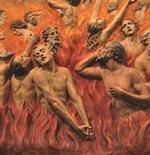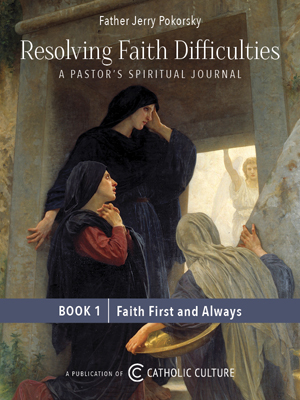Make your gift today!
Help keep Catholics around the world educated and informed.
Already donated? Log in to stop seeing these donation pop-ups.
Catholic Activity: Feast of the Holy Trinity
Father Weiser explains the history and liturgy of the Trinity, including the sign of the cross. He also covers the folklore of the Trinity, including symbols, shrines and columns, popular celebration and superstitions.
DIRECTIONS
HISTORY AND LITURGY
ORIGIN — The greatest dogma of the Christian faith is the mystery of the Holy Trinity. (Mystery, in this connection, means a supernatural fact revealed by God which in itself transcends the natural power of human reasoning.) During the first thousand years of Christianity there was no special feast celebrated in honor of this mystery, but, as Pope Alexander II (1073) declared, every day of the liturgical year was devoted to the honor and adoration of the Sacred Trinity.1
However, to counteract the Arian heresy, which denied the fullness of divinity to the Son, a special Mass text in honor of the Holy Trinity was introduced and incorporated in the Roman liturgical books.2 This Mass was not assigned for a definite day but could be used on certain Sundays according to the private devotion of each priest. (Such Mass texts which are not prescribed but open to choice on certain days are now known as "votive Masses.") From the ninth century on, various bishops of the Frankish kingdoms promoted in their own dioceses a special feast of the Holy Trinity, usually on the Sunday after Pentecost. They used a Mass text that Abbot Alcuin (804) is said to have composed.
Thus the custom of observing a special feast in honor of the Trinity became increasingly popular in the northern countries of Europe.3 Several synods prescribed it for their respective territories in France, Germany, England, and The Netherlands. In the thirteenth century the orders of the Benedictines and Cistercians adopted the annual celebration of the feast. It was kept on different Sundays in different places, until in 1334 Pope John XXII accepted the festival into the official calendar of the Western Church and ordered that henceforth it should be held everywhere on the Sunday after Pentecost.4
A new Mass text was written and published. It is interesting to note that the beautiful Preface of the Trinity as read today is the same one that appeared in the first text of the Sacramentary of Saint Gregory the Great.5 Most of the other prayers are of later origin. The Divine Office in its present form was arranged under Pope Saint Pius V (1572). It is one of the most sublime offices of the breviary.
The Feast of the Holy Trinity now belongs among the great annual festivals of Christianity. Although it is not observed with additional liturgical services outside the Mass, its celebration quickly took root in the hearts and minds of the faithful, and in all countries of Europe popular traditions are closely associated with this feast.
SIGN OF THE CROSS — The making of the sign of the cross, which professes faith both in the redemption of Christ and in the Trinity, was practiced from the earliest centuries. Saint Augustine (431) mentioned and described it many times in his sermons and letters.6 In those days Christians made the sign of the cross (Redemption) with three fingers (Trinity) on their foreheads. The words ("In the name of the Father and the Son and the Holy Ghost") were added later. Almost two hundred years before Augustine, in the third century, Tertullian had already reported this touching and beautiful early Christian practice:
In all our undertakings — when we enter a place or leave it; before we dress; before we bathe; when we take our meals; when we light the lamps in the evening; before we retire at night; when we sit down to read; before each new task — we trace the sign of the cross on our foreheads.7DOXOLOGY — The ancient Christian doxology (prayer of praise) "Glory be to the Father, and to the Son, and to the Holy Ghost" was used in the Oriental Church. The second part ("as it was in the beginning...") seems to have been added at the time of Emperor Constantine.8 During the fifth century this beautiful short prayer came into the Western Church and spread very quickly. Since then it has been in constant use in both liturgical and private devotions. Finally, the Council of Narbonne (589) prescribed that it should be added after every psalm and hymn in the Divine Office.9 It is an ancient tradition that in poetical hymns of the liturgy the Gloria Patri is rendered in a paraphrase (free version) within the last stanza.
EASTERN RITES — The churches of the Byzantine Rite do not celebrate the Feast of the Holy Trinity. Instead, they observe the Sunday after Pentecost as the Feast of All Saints (Kyriake Ton Hagion Panton). The official calendar of the Greek Church announces this feast with the interesting words "Today, on the first Sunday after Pentecost, we celebrate the festive day of all Saints everywhere in the world: in Asia, Lybia, in northern and eastern Europe."10 As may be seen from the territories mentioned, the term "whole world" applies only to the countries of that rite. The Uniate Armenians keep the Feast of the Holy Trinity on the same day as the Latin Church.11
FOLKLORE
SYMBOLS — During the first centuries of the Christian era the Holy Trinity was sometimes represented in paintings by three young men of identical shape and looks. By the sixth century, however, it had become an accepted practice that only the Father and Son should be shown in human form; the Holy Spirit is represented by the figure of a dove.12
In medieval times there were many imaginative and symbolic pictures, as well as designs, to indicate the great mystery of the faith. The Church has not officially accepted any of them, has tolerated some, forbidden others. One of the best-known symbols of this kind is the trefoil (shamrock). A second plant to which this symbolism is attached is the pansy (viola tricolor), which even today is called "Trinity flower" in many parts of Europe. In Puerto Rico a delicately perfumed white flower with three petals is called Trinitaria. Another symbol is the figure of a triangle (Trinity) surrounded by rays (divinity) with the picture of an eye inside the triangle (omniscience and providence). This design became very popular and may be found all over Europe in homes, on wayside shrines, and even in churches. An interesting version of this symbol may be seen in the Great Seal of the United States (reproduced on every one-dollar bill).
Centuries ago, architecture made use of many, and sometimes strange, symbols to indicate the Trinity, like three animals (hares, stags, birds) in a circle, or three interlocked rings, or a candle with three flames. Some churches display an architectural number symbolism in honor of the Trinity. One of the most remarkable examples of this kind is the Holy Trinity Church of Stadl-Paura, Austria, built in 1722. It has three aisles, three towers, three doors, three windows on either side, three altars, three bells, and three rows of pews.13
SHRINES AND COLUMNS — From the fourteenth century on, the Holy Trinity was generally invoked for help against the dreaded epidemics of the Black Death. Hundreds of Trinity churches in Europe owe their existence to public vows made in time of pestilence and cholera. In subsequent ravages of those terrible diseases, these churches became much-frequented pilgrim shrines. Later, during the seventeenth and eighteenth centuries, public columns in honor of the Holy Trinity were placed in the main squares of cities and towns in central Europe.14 Sculptured in marble or granite, they carry the traditional image of the Trinity and statues of the saints who were patrons against epidemics. Many of these columns are outstanding examples of late baroque art. The city of Vienna alone has eleven such Trinity columns which were erected during the epidemics of 1679 and 1713.15
POPULAR CELEBRATION — During the late Middle Ages and up to the eighteenth century, the Feast of the Holy Trinity was celebrated with popular manifestations of solemnity, special honor, and joy. As an example may serve the festival at the Trinity column of downtown Vienna, in 1680, where the famous Augustinian preacher Abraham a Santa Clara (1709) delivered a sermon before many thousands in the festively decorated square. At the end he appealed to the choir band to express with their instruments the honor, adoration, and gratitude of all to the Holy Trinity, "upon which the whole group of many trumpets and kettle-drums right joyfully broke out in a ringing fanfare."16
A proof of the great devotion to the Trinity was the Holy Trinity Confraternities, which flourished to such a degree during the seventeenth century that they surpassed most of the other similar organizations both in the number of local groups and in membership.17
SUPERSTITIONS — Whatever the weather on Trinity Sunday, it is said to be good and wholesome. Trinity rain" is credited with special powers of health and fertility. Ghosts and witches are prevented from doing harm. Magic flowers blossom at midnight bestowing on their finders all kinds of miraculous benefits like the healing of diseases, discovery of hidden treasures, protection against accidents, and freedom from pain for the rest of the year.18
On the other hand, in popular fantasy the neglect or desecration of this great Sunday is punished with dire misfortune. Those who refuse to attend service or who do menial work will suffer sickness, accidents, or even death within the year. Any work with metal instruments (including sewing needles) will bring the additional punishment of drawing lightning upon the house for the rest of the season. This superstition derives (as does that of Ascension Day) from the ancient lore of the death demons roaming the earth at this season of the year.19
ENDNOTES
1 Decret. Quoniam; Latin text in Nilles, II, 460. 2 Lib. Sacram., 103; PL, 78, 116 ff. 3 Jgn GK, 226; Rup. Tuit., De divin. offic., 11, 1; PL, 170, 293. 4 Nilles, II, 461. 5 Sacram. Gregor.; PL, 78, 116. 6 VdM, 415 ff. 7 De Corona, 3; PL, 2, 80. 8 Nilles, II, 462 f. 9 Can. 2; Mansi, 9, 1015. 10 Nilles, II, 424 (Greek and Latin text). 11 Nilles, II, 579. 12 K. Künstle, Ikonographie der christlichen Kunst, Freiburg, 1928, I, 221 ff. 13 Gugitz, I, 294 ff. (Verehrung und Brauchtum der Hl. Dreifaltigkeit). 14 VL, 62. 15 Gugitz, I, 298. 16 F. Loidl, Menschen im Barock, Wien, 1938, 16. 17 VL, 63. 18 Gugitz, I, 295 f.
19 ES, 20.
Activity Source: Handbook of Christian Feasts and Customs by Francis X. Weiser, S.J., Harcourt, Brace and Company, New York, 1958






